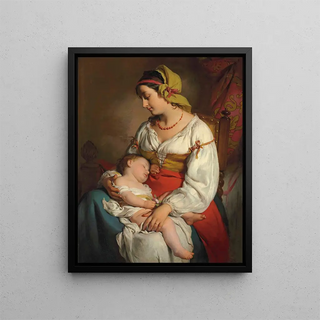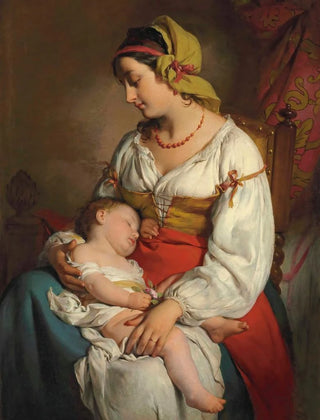Art print | Italian mother with child - Friedrich von Amerling


View from behind

Frame (optional)
Friedrich von Amerling's "Mother with Child" is a true ode to motherhood, capturing the very essence of love and tenderness between a mother and her child. This painting, created in the heart of the 19th century, reflects an era when art served as a mirror to the deepest human emotions. The artist manages to transcend a simple portrait to offer an intimate scene, where every detail and expression seems to pulse with life. Through this art print, viewers are invited to immerse themselves in a universe where gentleness and human warmth blend with technical virtuosity.
Style and uniqueness of the work
Friedrich von Amerling's technique is distinguished by its finesse and attention to detail. In "Mother with Child," light plays a crucial role, illuminating the faces with palpable softness. The colors, carefully chosen, evoke a warm palette that enhances the emotion conveyed by the scene. The drapery of the clothing, meticulously rendered, adds a tactile dimension to the piece, creating a dialogue between the viewer and the characters. The composition is balanced, with each element in its place, contributing to the overall harmony. Amerling succeeds in capturing not only the physical appearance of the subjects but also their essence and relationship. This art print is a celebration of life, a tribute to the beauty of family bonds.
The artist and his influence
Friedrich von Amerling, an Austrian painter of the 19th century, is often regarded as one of the masters of portraiture. His style is marked by a constant pursuit of technical perfection and sensitivity to human emotions. Influenced by the great masters of painting, he developed a unique artistic language, blending realism and romanticism. His works, often populated by female figures, explore themes of motherhood, beauty, and intimacy. Amerling also played a key role in the development of Austrian art as a court artist, entrusted with prestigious commissions. The impact of his work extends beyond his era, inspiring many contemporary and future artists to explore the depth of human relationships.

Matte finish

View from behind

Frame (optional)
Friedrich von Amerling's "Mother with Child" is a true ode to motherhood, capturing the very essence of love and tenderness between a mother and her child. This painting, created in the heart of the 19th century, reflects an era when art served as a mirror to the deepest human emotions. The artist manages to transcend a simple portrait to offer an intimate scene, where every detail and expression seems to pulse with life. Through this art print, viewers are invited to immerse themselves in a universe where gentleness and human warmth blend with technical virtuosity.
Style and uniqueness of the work
Friedrich von Amerling's technique is distinguished by its finesse and attention to detail. In "Mother with Child," light plays a crucial role, illuminating the faces with palpable softness. The colors, carefully chosen, evoke a warm palette that enhances the emotion conveyed by the scene. The drapery of the clothing, meticulously rendered, adds a tactile dimension to the piece, creating a dialogue between the viewer and the characters. The composition is balanced, with each element in its place, contributing to the overall harmony. Amerling succeeds in capturing not only the physical appearance of the subjects but also their essence and relationship. This art print is a celebration of life, a tribute to the beauty of family bonds.
The artist and his influence
Friedrich von Amerling, an Austrian painter of the 19th century, is often regarded as one of the masters of portraiture. His style is marked by a constant pursuit of technical perfection and sensitivity to human emotions. Influenced by the great masters of painting, he developed a unique artistic language, blending realism and romanticism. His works, often populated by female figures, explore themes of motherhood, beauty, and intimacy. Amerling also played a key role in the development of Austrian art as a court artist, entrusted with prestigious commissions. The impact of his work extends beyond his era, inspiring many contemporary and future artists to explore the depth of human relationships.






